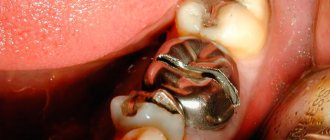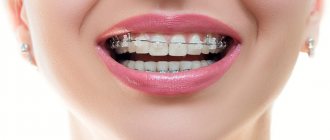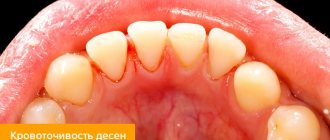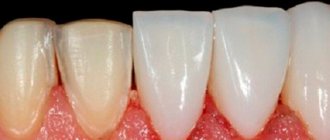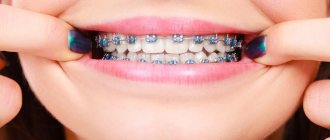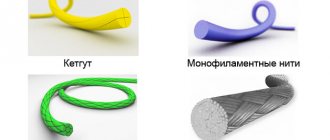Veneers are a great way to restore the attractiveness of your smile and change the aesthetics of your bite. Externally, veneers look like onlays - they are installed on the front part of the teeth, matching the color to the actual or desired color of the enamel. Microprosthetics technology requires mandatory tooth preparation - grinding down the enamel by 0.3-1 mm. It is this feature that becomes a frequent cause of questions from patients in dental clinics: is it painful to place veneers, are the onlays felt when worn.
Installation of zirconium dioxide veneers
The most modern version of microprostheses are zirconium veneers.
Zirconium veneers have maximum strength and high aesthetics. True, if they are made from transparent zirconium blocks from trusted material manufacturers. If the overlays are made of zirconium of an opaque, milky shade, they can have a rather unnatural appearance. USEFUL TO KNOW: Some clinics offer the installation of veneers at a special price. In such advertisements you can see fairly low prices for zirconium veneers. From 20,000 rubles for one microprosthesis. However, there is no need to rush to rejoice, and especially not to contact this particular dentistry. Most likely, at this cost, patients are offered veneers made of opaque zirconium. Yes, of course, they are durable, but they will look very similar to artificial teeth!
How much does it cost to install zirconium veneers on front teeth? About 50,000 rubles for a veneer per tooth.
The type of microprosthesis must be chosen before installing veneers, and it is best if you do this together with your doctor! The specialists of our clinic in Moscow “Aesthetica” will be happy to tell you in detail about what installation of veneers is, how it goes and choose the type of microprostheses that will suit you in terms of key characteristics, aesthetics and cost!
Increased sensitivity
Often, the increase in sensitivity after fixation of veneers increases significantly during their operation. Most often this is due to grinding off more enamel than required.
To correct the situation, the dentist performs the following actions:
- removes bacterial plaque and stone from enamel, performs professional cleaning of row elements;
- carries out fluoridation of the treated units - applies a special composition containing micro- and macroelements to the lingual surface of the incisors in order to increase the strength of the teeth and resistance to acids and bacteria.
If these measures do not help, the dentist opens the tooth and removes the bundle of nerve fibers. This eliminates sensitivity, but has a negative impact on the strength of the jaw element; as a rule, it is completely destroyed in less than 10 years.
Installation of composite veneers
Installing composite veneers is an opportunity to get a beautiful smile quickly and inexpensively. The doctor makes such veneers directly on the patient’s teeth, using ordinary filling material. Therefore, these microprostheses also have a second name - direct veneers.
The cost of installing veneers made of composite material seems attractive to many patients, because it is really quite low - from 5,000 rubles per unit. However, we do not advise you to choose this particular type of veneers, because at an affordable cost they have a large number of disadvantages.
Among the disadvantages of composite veneers:
- The aesthetic appearance of veneers made of composite material is quickly lost under the influence of external factors. If you take poor care of your oral cavity, and also smoke or often drink strong tea and coffee, the composite veneers will quickly darken;
- Composite veneers are not distinguished by their high strength. They may chip or crumble, and then you will have to go to the clinic again to install veneers, which means new expenses.
Composite veneers can be considered as a temporary option: when finances are not enough for more modern and expensive types of microprostheses. In addition, installing composite veneers requires high skill of the doctor, because not every specialist is able to create a beautiful and anatomically accurate tooth surface!
Causes of complications
Microprosthetics using veneers is intended both to improve the aesthetics of the smile area and to protect teeth from various damage to the enamel. However, there are a number of reasons that can cause complications to develop after the procedure.
Dentists list the most common of them:
- excessive grinding of enamel with damage to dentin leads to increased sensitivity when in contact with cold and hot drinks and dishes;
- discrepancy between the size of the plates and the height and width of the teeth entails the creation of pressure on the gums or adjacent elements, which can cause irritation and damage to soft tissues;
- application of a low-quality adhesive composition , as a result of which, over time, a gap forms between the veneer and the tooth, into which food particles penetrate, causing the formation of plaque with the subsequent development of caries;
- incorrect application of the composite material - violation of the technology can lead to overdrying of the enamel and dentin with subsequent cracking of the tooth;
- chipping of part of the veneer as a result of strong impact on the teeth - as a result, the ground incisor is subjected to pressure while eating, which causes pain and discomfort.
Most of the reasons for the development of complications are caused by unprofessional actions of the dentist in the process of fixing microprostheses.
In addition, negative consequences often develop in the presence of complex malocclusion pathologies, the habit of grinding teeth, diseases of the gums and enamel.
How is veneers installed on teeth?
Photo session and diagnostic impressions
A photo session is carried out with a macro lens to visually analyze the patient’s smile in real time. The desired color of future veneers is selected and impressions are taken of the teeth for which veneers will be made.
Making a wax model
In dental laboratories in Berlin, Los Angeles or Moscow, a technician uses wax to model the future shape of new teeth, based on the wishes of the doctor and the patient.
Trying on a wax model to visualize the future result
With the help of special keys and plastic, the future shape of the new teeth is transferred to unaffected teeth and the patient can already see the future result at this stage.
Taking final impressions
No teeth grinding required! Only slight grinding is done within the enamel in the places required for this, and impressions are taken for permanent work. While the veneers are being made, the patient wears temporary plastic veneers.
Trying on and fixing permanent veneers
Already made veneers are tried on the patient’s teeth using a special gel. A photo session is conducted to analyze the smile together with the patient. Next, fixation is performed, after which the tooth and veneer become one.
Installing veneers is a painless procedure and there is no need to be afraid of it. It does not involve drilling teeth, which is so scary for many people. First, you need to go to the clinic and undergo an examination in a specialist’s office. The doctor will examine you and tell you whether installing veneers will help solve your specific problem.
If the examination does not reveal any problems with the condition of the teeth and oral cavity, the next step will be to draw up a treatment plan and select microprostheses that will be used in aesthetic restoration. Installing veneers is an expensive procedure, and therefore it is very important that the treatment plan is detailed and the patient understands what the final price he will have to pay for aesthetic restoration and why.
Does the installation of veneers require grinding of teeth? In some cases, yes. This is necessary so that the veneers fit as tightly as possible to the teeth and look natural on the dental surfaces. But if modern glass-ceramic veneers are used or those manufactured using high-tech equipment, the installation of veneers can be carried out without preliminary grinding of the teeth.
USEFUL TO KNOW: Grinding teeth is a procedure that cannot be called useful. Teeth with worn down enamel become vulnerable to external factors, carious bacteria and other pathogenic microorganisms. In addition, if the installation of veneers was carried out with the grinding of teeth, you will never be able to remove the veneers and start walking with your natural teeth. Therefore, when deciding to resort to aesthetic dental restoration with veneers, it is optimal to choose the type of onlays whose installation does not require grinding down the enamel!
After examination and diagnosis, as well as taking impressions of dental surfaces, all information is transferred to the dental laboratory, where, based on the available data, veneers are produced in the required quantity. The installation of veneers is rarely done on all teeth in the oral cavity: most often, veneers are made only for those dental units that fall in the smile area and are therefore clearly visible to others when communicating.
When the microprostheses are ready, the final stage of aesthetic restoration begins, that is, the installation of veneers. But before attaching the plates to your teeth with a permanent fixing compound, the doctor will definitely try on the finished veneers. This is necessary in order to make sure that the microprostheses are made with high quality and will not cause any discomfort to the patient during use.
Installing veneers involves gluing onlays to dental surfaces using special dental cement, the shade of which is selected so that the composition does not show through thin plates of ceramic or zirconium.
How long do your teeth hurt after installing veneers? Doctors hear this question from patients quite often, and the answer to it is: if the installation of veneers was carried out efficiently, on healthy teeth, then no pain after the procedure should bother you at all!
In order for you to fully understand how the installation of veneers takes place, we are posting a video in the article containing all the main stages of the process.
Installation of veneers: does it require special preparation?
Before installing veneers, your teeth definitely need to be properly prepared. A mandatory procedure will be professional sanitation of the oral cavity, which allows you to efficiently clean the dental surfaces of all types of plaque. In some cases, it is necessary to carry out preliminary dental treatment for caries, because veneers are always installed on healthy teeth!
What to do if a tooth hurts under a denture?
If toothache occurs after dentures, the first priority is to identify the cause as soon as possible and apply appropriate therapeutic measures. This problem will not resolve on its own, and any home remedies will not be effective. Therefore, do not wait and contact your dentist for professional help.
If the dentist discovers a tooth infection under the crown, he or she may recommend root canal treatment, which usually requires removal of the denture. In some cases, a hole can be drilled into the crown, allowing the dentist to access the root canal without having to remove and install another crown. This is a complex operation, but it will save you money since the removed crowns are often no longer reusable.
Do your teeth hurt after getting veneers?
As we wrote above, if the installation of veneers was carried out efficiently, then pain should not bother the patient in principle. However, sometimes pain does occur. What can pain indicate after installation of veneers? Here are possible types of complications in which the patient may experience pain and discomfort:
- Individual reaction to low-quality fixative composition;
- Incorrect veneer size. Because of this, the microprosthesis can put pressure and injure sensitive gum tissue;
- High and unpleasant sensitivity after installation of veneers may occur in teeth from which too much enamel has been removed.
Eliminating all of the listed side effects will require both time and additional financial costs, and therefore it is so important that the installation of veneers takes place at all stages with strict adherence to technology!
Therefore, if you want the process of installing veneers to go without complications and you do not experience pain or other discomfort, you should always choose a clinic for the service carefully! Study reviews about the installation of veneers in Moscow in a specific clinic, find out about the reputation of its doctors and equipment.
Indications and contraindications
Despite the fact that dental plates are a safe design that causes complications only in exceptional cases, they are recommended to be used only when indicated. The patient's desire alone is not enough for reconstruction.
Indications for this method of tooth reconstruction:
- damage, chipping or disruption of the natural structure (enamel);
- irregular shape;
- altered or natural “ugly” color;
- gaps or incorrect positioning;
- cracks;
- tetracycline
- hypoplasia or fluorosis;
- wedge-shaped defect.
In a professional clinic, services are not provided without preliminary diagnostics, the purpose of which is to identify the possible presence of contraindications:
- abrasion of dental tissues;
- significant curvature of the tooth;
- bruxism or stomatitis;
- periodontitis, caries or pulpitis;
- periodontitis, gingivitis or periodontal disease.
The doctor may refuse to allow the patient to undergo the procedure if the bite is severely altered, or there is a significant deformation of the position of the teeth, or if there is a large filling. It is also not recommended to place plates on people who do not sufficiently observe hygiene standards. The use of narcotic drugs is considered an absolute contraindication. It is also not advisable for smokers to install plates, since this method of reconstruction will be pointless due to the rapid darkening of the material of the plates.
Installation of veneers: price in Moscow
How much does it cost to install veneers on teeth in Moscow? The answer to this question will depend on what type of microprostheses you choose for aesthetic restoration, how many plates will need to be made and using what technology. We indicated approximate prices for veneers above, talking about the types of onlays used in aesthetic dentistry. Knowing the number of teeth that need to be restored, you can approximately calculate how much it will cost you to install veneers.
If you are interested in the exact price of a service, it is best to consult a doctor who will draw up a treatment plan and specify the specific amount of your future costs.
Installation of veneers is one of the services that our dental clinic in Moscow, Aesthetica, offers its patients. Reviews on our Instagram page can help you evaluate the quality of the veneers we install. If you need detailed professional advice and help in choosing the types of veneers, come and see our specialists at any time convenient for you!
Installing veneers is a great opportunity to become the owner of a magnificent, attractive smile and stop being shy to smile and communicate openly with people! We will be happy to help you acquire both a beautiful smile and self-confidence!
Fixation problems
The main mistake dentists make when attaching veneers is applying a low-quality adhesive composition. The consequence of this may be its expansion when temperatures change, cracking and detachment from the tooth surface.
When a patient complains of pain after fixing veneers, a specialist will remove the plates and examine the tooth surface.
Further actions depend on the state of the row elements:
- If there are no signs of inflammatory processes, the linings are reattached using a better composition.
- If signs of carious damage are detected, treatment is performed - the affected tissue is removed, the resulting defects are filled with photopolymer material.
- If the pulp becomes infected, actions are taken to save the nerve - the tooth is cleaned of adhesive, bacterial plaque and affected tissue, inflamed and dying cells are removed. The canals are cleared of purulent contents and treated with antiseptic drugs. The resulting cavities are filled.
After treatment, in the absence of contraindications, the plates are again attached to the teeth.
USEFUL RECOMMENDATIONS
Today, patients in dental clinics place high demands on the aesthetics of their teeth. There is an opinion: a successful person has a radiant smile.
But not every person over the age of 30 decides to completely restore the integrity of the ranks. As a rule, patients turn to doctors with the desire to restore the frontal area, that is, the smile area.
When the lateral units are destroyed or missing, a person begins to chew food with the incisors. But these organs are not intended for chewing processes; they can only be used to bite off.
Not only the enamel, but also the aesthetic plate is unable to withstand such loads. The veneers crack, the enamel begins to wear off intensively, pain and other complications appear. Therefore, before veneering, it is very important to think not only about the beauty, but also about the health of all teeth.
It is also worth remembering that in restoration much depends on the specialist. Aesthetic dentistry requires from the doctor not only experience and professionalism, but also artistic abilities.
It is important to find a good clinic and a dentist who knows his business and knows how to efficiently apply innovative methods for correcting dental defects in practice.
To extend the life of the products, the patient must scrupulously follow the recommended care rules:
- minimize the consumption of foods and drinks with coloring properties;
- stop smoking;
- do not allow the units to be exposed to solid objects;
- use a mouth guard when playing sports;
- brush your teeth twice a day;
- rinse your mouth after every meal;
- use a paste with a low abrasive content;
- avoid using tooth powder;
- maintain hygiene at the proper level with the help of an irrigator;
- visit the dentist once every 3 months;
- carry out professional cleaning in the clinic;
- visit a hygienist.
Reviews
Fixing veneers is an irreversible procedure, since the ground teeth will constantly need protection.
Therefore, it is necessary to approach veneering responsibly - find a qualified specialist, carry out sanitation of the oral cavity and follow all the recommendations of the attending physician.
This will help reduce the risk of pain and the development of other pathologies after the restoration procedure.
Share your experience of installing veneers - have you ever experienced pain or suffered from other complications after the procedure? Please leave feedback in the comments section at the end of the article.
If you find an error, please select a piece of text and press Ctrl+Enter.
Tags tooth pain veneers prosthetics
Did you like the article? stay tuned
No comments yet
